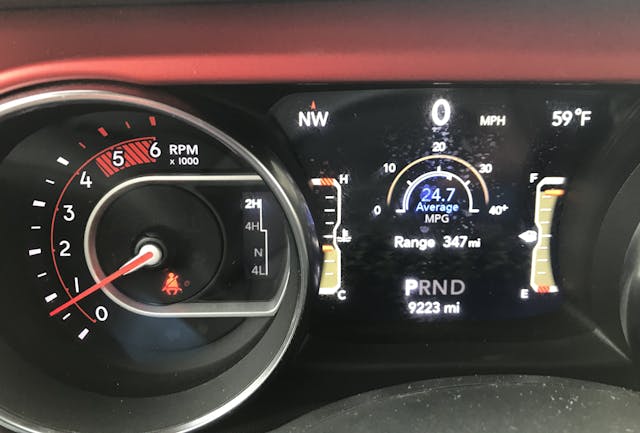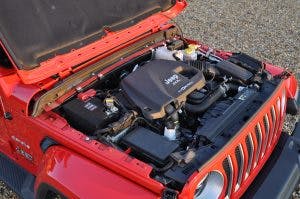Media | Articles
The EcoDiesel is the best Jeep Wrangler engine
Jeep recently teased a Wrangler with a 392 V-8 engine. Jeep called it a “concept” but for some reason it secretly made several dozen of them, wink wink. The V-8 making its way into the Wrangler should not be a surprise—remember, the same outfit wedged a Hellcat engine into the Durango. The V-8 is not the best engine for the Wrangler, however. It’s too big, too thirsty, and, let’s just all agree, too powerful for a Jeep.
The perfect Wrangler powertrain is already available, and it will soon be coming to the Gladiator pickup truck, too. The turbocharged, 60-degree, diesel-powered DOHC 3.0-liter V-6, makes only 260 horsepower but it churns out a fantastic 442 lb-ft of torque from 1400–2800 rpm. For perspective, that is 70 percent more than the 3.6-liter Pentastar V-6 gasoline engine.
How does that torque impact the Wrangler?
In a word, dramatically. The Wrangler now hauls ass. Under hard highway acceleration, the rear squats, the front lifts, and it just goes. Quick highway passing is a tip of a toe away. Cruising at those speeds is similarly simple, as if the Wrangler were a much louder, taller German sedan. Meanwhile, with the diesel, this off-roader can return an EPA-rated 30 miles per gallon on the highway.
Jeep’s true domain, of course, is off-road, where low-end torque and proper throttle response are essential. The EcoDiesel is well-suited for those needs, not to mention the Wrangler’s solid axles, low gearing, available locking differentials, and proper tires.
The engine
Jeep’s diesel engine is made by Italian VM Motori S.p.A., which is owned by Fiat Chrysler (FCA), or as it’ll soon be known, Stellantis. This is the 3.0-liter EcoDiesel V-6’s third generation, but its first application in the Wrangler. The engine differs slightly from the second-generation version, last used in the 2018 Grand Cherokee. Jeep redid the cylinder head intake ports, made the exhaust gas recirculation (EGR) system into dual loop (low and high pressure) system, and slapped new pistons into the cylinders, reducing the compression ratio from 16.5:1 to 16.0:1. Finally, it features a new variable-geometry turbocharger.
Marketplace
Buy and sell classics with confidence
It should be noted that, in 2017, the EPA filed a civil complaint against FCA alleging the company used defeat devices on approximately 104,000 2014-2016 Ram 1500 and Jeep Grand Cherokee vehicles with diesel engines. Those models were under scrutiny for violating the Clean Air Act and California Law. The case was settled in January of 2019. Fiat Chrysler has agreed to implement a recall program to repair non-compliant diesel vehicles, offer an extended warranty on repaired vehicles, and pay a civil penalty of $305 million to settle claims of cheating emissions tests and failing to disclose unlawful defeat devices. FCA also implemented a program to mitigate excess pollution from these vehicles. The total cost to FCA for all of this was over half a billion dollars.
Differences between gas and diesel hardware
The diesel engine gets its own heavier-duty transmission, a ZF 8HP75 eight-speed automatic—the only available gearbox. That transmission has the same gear ratios as the one used with gasoline engines, and it is in the same family of ZF transmissions as the 850RE in other Wranglers. The difference is that the 8HP75 is rated to 900Nm (664 lb-ft), whereas the 850RE is rated to 500 Nm, (369 lb-ft).
Similarly to the gasoline-engine units, two part-time transfer cases are available on the diesel Wranglers. The Rock-Trac NV241OR is a two-speed transfer case with a 4.0:1 low-range gear ratio on Rubicon models. The Command-Trac NV241 is part-time two-speed transfer case with a 2.72:1 low-range gear ratio for Sport and Sahara models. The 2.72:1 Selec-Trac Full-Time 4WD System that is available on Sahara with gasoline models is not available with the diesel engine. The addition of the Selec-Trac Full-Time 4WD System replaces the front axle universal joints with constant-velocity joints to make turning smoother.
Diesel-powered Wranglers are geared differently than other Wranglers., with a 3.73:1 differential gearing versus the conventional gasoline Wrangler gearing of 3.45:1. Gasoline-powered Rubicons have 4.10:1 gearing. The diesel Rubicons, of course, have locking differentials front and rear, whereas others have limited-slip rear diffs. All of this gearing goodness is housed within Dana 44 axles—M210 in the front and M220 in the rear. EcoDiesel models and all Rubicons have axles that are 1.5 inches wider than Sport or Sahara models.
Another change from the gasoline version of the Wrangler is evident in the exhaust system. The thick pipe, at least 2.5 inches in diameter, originates at the turbo. It seems buried toward the back of the V-shaped engine and meanders along the passenger side of the vehicle, while a huge catalytic converter with Selective Catalytic Reduction runs alongside the transmission.
The SCR operates at higher temperatures than a conventional gasoline catalytic converter. Therefore, the dual-loop Exhaust Gas Recirculation system (which recirculates a portion of the exhaust gases back to the engine, reducing Nitrogen Oxides (NOx) emissions) runs at higher temperatures, too. An EGR cooler had to be installed to reduce the temperature of those exhaust gases before they get recirculated back into the engine air intake system.
There are no changes to the heavy-duty brakes from the ones on the Sahara and Rubicon gasoline models. There is, however, a different steering ratio; the diesel model gets a rack with an overall ratio of 14.3:1 vs. 15.6:1. This slightly reduces the lock-to-lock steering wheel turns, from 3.2 to 3.13. The difference is almost unnoticeable, but Jeep made the change to account for the diesel model’s additional weight. (Typically, off-road worthy 4x4s tend to have slower steering racks so that the driver has more control when wheeling over the obstacles. Sports cars tend to have quicker racks.)
The fuel tank is also different, shrinking from 21.5-gallon capacity in the gasoline models to 18.3 gallons in the diesel. This is due to the addition of a 5.1-gallon diesel exhaust fluid (DEF) tank. DEF refills align with oil changes, lasting up to 10,000 miles. Levels can be monitored via a digital DEF gauge display in the gauge cluster. Since DEF freezes at −11 °C (12 °F), all DEF tanks have a heater designed to melt the fluid as quickly as possible. Despite its smaller fuel tank, the Wrangler EcoDiesel has a higher maximum driving range of 530 miles, versus 430 miles for a comparable gasoline V-6 model.
All of those components are bolted up to the same Wrangler frame that is used with the gasoline engine. Engine and transmission mounts were significantly upgraded, however, to handle the extra weight and torque output of the diesel. Finally, an intercooler is installed in front of the radiator.
Only from the rear of the vehicle can onlookers discern visual differences between the gas and diesel models. The DEF tank is visible below the bumper on the left side, and the exhaust, with its boxy muffler, is routed to the right side. Finally, there is a small EcoDiesel badge under the passenger-side taillight.
Heavy weight
That turbodiesel engine and beefed-up chassis do add weight to the Wrangler. The difference between comparably equipped 3.6-liter and diesel versions is as much as 487 pounds on the Sport model. The heaviest model is the Rubicon, at 4862 pounds with the soft top. Either of the two available hardtops will add to that figure.
To accommodate the extra weight, suspension spring rates are unique to the diesel models. Front spring rates are 9.7 percent higher and rear are 9.0 percent higher. Shocks are re-valved accordingly. There is no difference in ride height, and sway bars remain the same but, as always, the Rubicon’s front sway bar can be disconnected when in 4WD-Low.
The payload capacity of the diesel Wrangler is slightly affected by all this weight, dropping by 68 pounds from the gasoline model to 1136 pounds. Maximum trailer weight has not changed from 3500 pounds, even if such a load will be much easier to pull with the diesel engine.
Downsides
Yes, more power is nice. Better fuel mileage is certainly a welcome benefit, too. As with most things, though, there are downsides to all this diesel goodness. First, the price: The engine alone adds $4000 to the MSRP of any of the Wranglers on which it is offered. The required 8HP75 transmission is another $2000. This adds 10–18 percent to the Wrangler’s price, depending on trim and options.
The secondary downside is handling. The bulk of the added weight is in the Jeep’s nose. Despite the modified suspension, the diesel Wrangler has a tendency to understeer, noticeably in highway curves at normal traffic speeds. I’ve noticed similar phenomena on the previous-generation Mercedes-Benz AMG G63—a off-road vehicle with military heritage that rode on stick axles, whose design was hardly best suited to a 563-horsepower twin-turbo V-8.
This diesel engine is loud, or at least louder than the Pentastar V-6 at start up and at idle, especially when standing outside the vehicle. The good news? Wind and/or tire noise takes over at more than 30 mph. It’s a Jeep thing, and no one will complain. Most drivers will, however, complain about the ESS, or Engine Stop-Start. The engine shuts off when the vehicle is stopped but still in drive. The constant stop and restart of the engine is downright annoying in traffic. Thankfully, the system can be disabled with press of a dash button. Solutions for a more permanent disablement are available via the aftermarket.
Why choose the diesel?
No one should be buying the diesel because of the financial benefits of fuel savings. It gets 22 mpg in the city and 29 mpg on the highway, whereas the 3.6-liter gasoline version gets 18 mpg in the city and 22 mpg on the highway, and the added up-front cost of the diesel renders this calculus essentially pointless. The diesel’s true appeal is its additional power and stronger chassis.
For casual Wrangler buyers, either of the two gasoline engines will work just fine. The EcoDiesel is directed specifically at the enthusiast market. Thousands of new Wrangler buyers immediately drop significant amounts of money in modifications, and these same people have been for years demanding a diesel option. Jeep is betting that those very customers will just empty every pocket, and throw in another $6000 for the privilege.
For Jeepers who add bigger, 35- or 37-inch, tires to their rigs, the additional twisting power is a thing of beauty. Similarly, the same customers are likely adding steel bumpers, winches, and of course roof racks, all of which adds significant weight. To assist these loyal Jeep fans, Mopar has even released a diesel-specific lift kit, no doubt based on those heavier spring rates.
Before long, the V-8 Wrangler is likely to make the jump from concept to reality. A plug-in hybrid Wrangler is coming very soon. Even with those options on the horizon, Wrangler fans should absolutely consider the diesel option. While the Hurricane and Pentastar gasoline engines are sufficient, the EcoDiesel completely transforms the feel of the vehicle, particularly if you plan to make the most of your Wrangler with Jeepy off-road antics.































